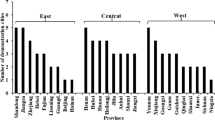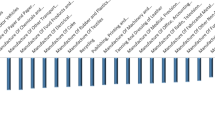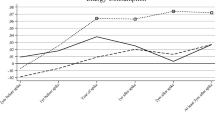Abstract
We identify factors influencing energy efficiency and the role of price instruments such as tax and technology use in reducing energy intensity at the firm level. We use data from 2001 to 2015 for India's manufacturing sector from the Centre for Monitoring Indian Economy. Our result strongly suggests that R&D and productivity have a positive impact on achieving energy efficiency. In such a case, at least one-to-one correspondence between the tax and energy intensity may help promote renewable energy use if they are subsidized and allowed to come under the provision of tax credit or tax exemption. Since price instruments do not produce any revenue recycling effect, policymakers can trade-off between increasing corporate tax and generating employment. Therefore, environmental regulations should strictly relate to increase energy efficiency and bring the manufacturing sector out of the productivity dilemma. Also, as evidence from the empirical analysis, there is an urgent need to substitute vintage capital with new capital and better technology. In addition to the existing liberalization policies, the Government must design green domestic policies for the manufacturing sector and map them with FDI and trade. As the polluted firms are energy-intensive, “Performance, Achievement and Trade” (PAT) policies need to focus on these firms.

Source: Authors’ estimation using data from the CMIE Prowess

Source: Authors’ estimation using data from the CMIE Prowess

Source: Authors’ estimation using data from the CMIE Prowess


Source: Authors’ estimation using data from the CMIE Prowess

Source: Authors’ estimation using data from the CMIE Prowess. Note: This is estimated by using the non-linear relationship model with pollution loads. Black dashed lines are OLS coefficients, and the continuous lines show the variation

Source: Authors’ estimation using data from the CMIE Prowess. Note: Mean values of R&D based on FDI for sample firms from 2001 to 2015
Similar content being viewed by others
Notes
For more information please see https://www.niti.gov.in/verticals/energy.
TFP is estimated using the methodology specified by Levinsohn and Petrin (2003).
References
Abraham, M. P., & Kulkarni, A. A. (2020). Price-coupling games and the generation expansion planning problem. Annals of Operations Research, 295(1), 1–19.
Acheampong, A. O., Amponsah, M., & Boateng, E. (2020). Does financial development mitigate carbon emissions? Evidence from heterogeneous financial economies. Energy Economics, 88, 104768.
Adom, P. K. (2015). Asymmetric impacts of the determinants of energy intensity in Nigeria. Energy Economics, 49, 570–580.
Agnani, B., Gutiérrez Huerta, M. J., & Padilla, M. A. I. (2007). R&D policy in economies with endogenous growth and non-renewable resources. DFAE-II WP Series, 1–40.
Amor, S. B., Frini, A., & Reinhardt, G. (2020). Preface: Multiple criteria decision making for sustainable decisions. Annals of Operations Research, 293(2), 401–403.
Bagchi, P., & Sahu, S. K. (2020). Energy intensity, productivity and pollution loads: Empirical evidence from manufacturing sector of India. Studies in Microeconomics, 8, 194–211.
Baloch, Z. A., Tan, Q., Iqbal, N., Mohsin, M., Abbas, Q., Iqbal, W., & Chaudhry, I. S. (2020). Trilemma assessment of energy intensity, efficiency, and environmental index: Evidence from BRICS countries. Environmental Science and Pollution Research, 27(27), 34337–34347.
Barro, R. J., & Sala-i-Martin, X. (1995). Economic Growth. McGraw-Hill.
Bator, F. M. (1957). The simple analytics of welfare maximization. The American Economic Review, 47(1), 22–59.
Caves, R. E. (1971). International corporations: The industrial economics of foreign investment. Economica, 38(149), 1–27.
Chan, N. W., & Gillingham, K. (2015). The microeconomic theory of the rebound effect and its welfare implications. Journal of the Association of Environmental and Resource Economists, 2(1), 133–159.
Chen, Z., Huang, W., & Zheng, X. (2019). The decline in energy intensity: Does financial development matter? Energy Policy, 134, 110945.
Cleveland, C. J., Costanza, R., Hall, C. A. S., & Kaufmann, R. (1984). Energy and the US economy: A biophysical perspective. Science, 225(4665), 890–897.
Co, C. Y., & List, J. A. (2004). Is foreign direct investment attracted to ‘knowledge creators’? Applied Economics, 36(11), 1143–1149.
Coase, R. H. (1960). The problem of social cost. In C. Gopalakrishnan (Ed.), Classic papers in natural resource economics (pp. 87–137). Palgrave Macmillan.
Colapinto, C., Jayaraman, R., Abdelaziz, F. B., & Torre, D. L. (2019). Environmental sustainability and multifaceted development: Multi-criteria decision models with applications. Annals of Operations Research, 293, 1–28.
Cole, M. A. (2004). Trade, the pollution haven hypothesis and the environmental Kuznets curve: Examining the linkages. Ecological Economics, 48(1), 71–81.
Coria, J., & Kyriakopoulou, E. (2018). Environmental policy, technology adoption and the size distribution of firms. Energy Economics, 72(1), 470–485.
Costa-Campi, M. T., García-Quevedo, J., & Segarra, A. (2015). Energy efficiency determinants: An empirical analysis of Spanish innovative firms. Energy Policy, 83, 229–239.
Dietzenbacher, E., & Mukhopadhyay, K. (2007). An empirical examination of the pollution haven hypothesis for India: Towards a green Leontief paradox? Environmental and Resource Economics, 36(4), 427–449.
Dunning, J. H. (1993). Multinational enterprises and the global economy. Addison-Wesley.
Emir, F., & Bekun, F. V. (2019). Energy intensity, carbon emissions, renewable energy, and economic growth nexus: New insights from Romania. Energy & Environment, 30(3), 427–443.
Gillingham, K (2011) The consumer response to gasoline price changes: empirical evidence and policy implications." Doctor of Philosophy, Department of Management Science and Engineering, Stanford University. http://www.yale. edu/gillingham/Gillingham_Dissertation_Final. pdf.
Gillingham, K., Rapson, D., & Wagner, G. (2016). The rebound effect and energy efficiency policy. Review of Environmental Economics and Policy, 10(1), 68–88.
Global, B. P. (2016). BP statistical review of world energy 2017. BP Global.
Gollop, F. M., Fraumeni, B. M., & Jorgenson, D. W. (1987). Productivity and us economic growth. Elsevier.
Hamilton, J. D. (2009). Understanding crude oil prices. The Energy Journal. https://doi.org/10.5547/ISSN0195-6574-EJ-Vol30-No2-9
Hu, A. G. Z., Jefferson, G. H., & Jinchang, Q. (2005). R&D and technology transfer: Firm-level evidence from Chinese industry. Review of Economics and Statistics, 87(4), 780–786.
Huang, J., & Chen, X. (2020). Domestic R&D activities, technology absorption ability, and energy intensity in China. Energy Policy, 138, 111184.
Huang, J., Hao, Yu., & Lei, H. (2018). Indigenous versus foreign innovation and energy intensity in China. Renewable and Sustainable Energy Reviews, 81, 1721–1729.
IEA, IEA (2015) India energy outlook." US Energy Information.
Jevons, W. S. (1865). The coal question: Can Britain survive? In A. W. Fluxed, & A. M. Kelley (Eds.), The coal question: An inquiry concerning the progress of the nation, and the probable exhaustion of our coal-mines. London: Macmillan & Co.
Jorgenson, D. W. (1998). Growth: Energy, the environment, and economic growth (Vol. 2). MIT Press.
Joseph, K. L. (2010). The politics of power: Electricity reform in India. Energy Policy, 38(1), 503–511.
Khazzoom, J. D. (1980). Economic implications of mandated efficiency in standards for household appliances. The Energy Journal. https://doi.org/10.5547/ISSN0195-6574-EJ-Vol1-No4-2
Koenker, R., & Ng, P. (2005). Inequality constrained quantile regression. Sankhyā: the Indian Journal of Statistics, 67(1), 418–440.
Kummel, R., Lindenberger, D., & Eichhorn, W. (2000). The productive power of energy and economic evolution. Indian Journal of Applied Economics, 8(2), 1–26.
Kummel, R., Strassl, W., Gossner, A., & Eichhorn, W. (1985). Technical progress and energy dependent production functions. Zeitschriftfür Nationalokonomie, 45(3), 285–311.
Levinsohn, J., & Petrin, A. (2003). Estimating production functions using inputs to control for unobservables. The Review of Economic Studies, 70(2), 317–341.
Lin, B., & Liu, H. (2015). A study on the energy rebound effect of China’s residential building energy efficiency. Energy and Buildings, 86, 608–618.
Lin, H., & Yeh, R.-S. (2005). The interdependence between FDI and R&D: An application of an endogenous switching model to Taiwan’s electronics industry. Applied Economics, 37(15), 1789–1799.
Malthus, T. R. (1798). An essay on the principle of population. London: Joseph Johnson.
Mardones, C., & Flores, B. (2018). Effectiveness of a CO2 tax on industrial emissions. Energy Economics, 71(1), 370–382.
Medema, S. G. (2017). Exceptional and unimportant’? The rise, fall, and rebirth of externalities in economic analysis. SSRN Electronic Journal. https://doi.org/10.2139/ssrn.3057411
Mill, JS (1848) Principles of political economy with some of their applications to social philosophy. Book IV, Chapter VI ‘of the Stationary State’.
Montalbano, P., & Nenci, S. (2019). Energy efficiency, productivity and exporting: Firm-level evidence in Latin America. Energy Economics, 79, 97–110.
Nordhaus, W. D. (2010). Economic aspects of global warming in a post-Copenhagen environment. Proceedings of the National Academy of Sciences, 107(26), 11721–11726.
Nordhaus, W. D. (2011). The architecture of climate economics: Designing a global agreement on global warming. Bulletin of the Atomic Scientists, 67(1), 9–18.
Oak, H, and S Bansal S (2017) Perform-Achieve-Trade Policy: A Case Study of Cement Industry for Energy Efficiency. No. 17–05. Centre for International Trade and Development, Jawaharlal Nehru University, New Delhi, India.
Oates, W. E. (1995). Green taxes: Can we protect the environment and improve the tax system at the same time? Southern Economic Journal, 61(1), 915–922.
Olmstead, S. M., & Stavins, R. N. (2006). An international policy architecture for the post-Kyoto era. American Economic Review, 96(2), 35–38.
Ouardighi, F. E., Khmelnitsky, E., & Leandri, M. (2020). Production-based pollution versus deforestation: Optimal policy with state-independent and-dependent environmental absorption efficiency restoration process. Annals of Operations Research, 292, 1–26.
Pachauri, R. K., & Reisinger, A. (2008). Climate change 2007. Synthesis paper. Contribution of working groups I, II and III to the fourth assessment paper. Cambridge University Press.
Pan, X., Uddin, M. K., Han, C., & Pan, X. (2019). Dynamics of financial development, trade openness, technological innovation and energy intensity: Evidence from Bangladesh. Energy, 171(1), 456–464.
Park, K. H. (2003). Patterns and strategies of foreign direct investment: The case of Japanese firms. Applied Economics, 35(16), 1739–1746.
Parker, S., & Liddle, B. (2016). Energy efficiency in the manufacturing sector of the OECD: Analysis of price elasticities. Energy Economics, 58, 38–45.
Pigou, A (2011) The economics of welfare. Library of Economics and Liberty." London: Macmillan and Co [4. ª edicao]. Consultado a 20, no. 09 (1932).
Pigou, A. C. (1920). The economics of welfare Macmillan and Co. United Kingdom.
Porter, M. E., & Van der Linde, C. (1995). Toward a new conception of the environment-competitiveness relationship. Journal of Economic Perspectives, 9(4), 97–118.
Richter, P. M., & Schiersch, A. (2017). CO2 emission intensity and exporting: Evidence from firm-level data. European Economic Review, 98, 373–391.
Sahu, S., & Narayanan, K. (2010). Determinants of energy intensity in Indian manufacturing industries: A firm level analysis. MPRA Paper, 21646, 1–26.
Sahu, S. K., & Sharma, H. (2016). Productivity, energy intensity and output: A unit level analysis of the Indian manufacturing sector. Journal of Quantitative Economics, 14(2), 283–300.
Samargandi, N. (2019). Energy intensity and its determinants in OPEC countries. Energy, 186, 115803.
Scitovsky, T. (1954). Two concepts of external economies. Journal of Political Economy, 62(2), 143–151.
Shen, X., & Lin, B. (2020). Policy incentives, R&D investment, and the energy intensity of China’s manufacturing sector. Journal of Cleaner Production, 255, 120208.
Shen, X., Lin, B., & Wei, Wu. (2019). R&D efforts, total factor productivity, and the energy intensity in China. Emerging Markets Finance and Trade, 55(11), 2566–2588.
Sidgwick, H. (1901) The principles of political economy. Vol. 132. Kraus reprint.
Stern, N. (2008). The economics of climate change. American Economic Review, 98(2), 1–37.
Stiglitz, J. (1974). Growth with exhaustible natural resources: Efficient and optimal growth paths. The Review of Economic Studies, 41, 123–137.
Tajudeen, I. A., Wossink, A., & Banerjee, P. (2018). How significant is energy efficiency to mitigate CO2 emissions? Evidence from OECD countries. Energy Economics, 72, 200–221.
Tamazian, A., Chousa, J. P., & Vadlamannati, K. C. (2009). Does higher economic and financial development lead to environmental degradation: Evidence from BRIC countries. Energy Policy, 37(1), 246–253.
Tang, E., Zhang, J., & Haider, Z. (2015). Firm productivity, pollution, and output: Theory and empirical evidence from China. Environmental Science and Pollution Research, 22(22), 18040–18046.
Wang, H., Chen, Z., Xingyi, Wu., & Nie, X. (2019). Can a carbon trading system promote the transformation of a low-carbon economy under the framework of the porter hypothesis? —Empirical analysis based on the PSM-DID method. Energy Policy, 129, 930–938.
Zhang, N., & Zhang, W. (2020). Can sustainable operations achieve economic benefit and energy saving for manufacturing industries in China? Annals of Operations Research, 290(1), 145–168.
Acknowledgements
We thank the anonymous referees for their useful comments and suggestions. The first author gratefully acknowledge the support from Initiative for Sustainable Energy Policy (ISEP) and ICSR IIT Madras, Chennai on initiating this research. Usual disclaimer applies.
Author information
Authors and Affiliations
Corresponding author
Additional information
Publisher's Note
Springer Nature remains neutral with regard to jurisdictional claims in published maps and institutional affiliations.
Appendix
Rights and permissions
About this article
Cite this article
Sahu, S.K., Bagchi, P., Kumar, A. et al. Technology, price instruments and energy intensity: a study of firms in the manufacturing sector of the Indian economy. Ann Oper Res 313, 319–339 (2022). https://doi.org/10.1007/s10479-021-04295-7
Accepted:
Published:
Issue Date:
DOI: https://doi.org/10.1007/s10479-021-04295-7




